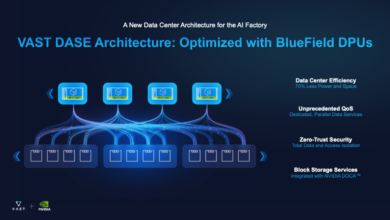What is multicloud architecture? | TechRepublic


The cloud has completely changed how businesses operate, allowing them to be more agile and dynamic with their strategies, offerings and resources. It’s almost impossible to imagine an organization that doesn’t use some form of cloud technology or service.
According to Gartner, 85% of organizations will be “cloud-first” by 2025. Companies are shifting their focus from on-premises hardware infrastructure to leveraging managed services offered in the cloud. Organizations now benefit from the lower total cost of ownership, easier access to new services, faster deployment times, and better scalability and availability.
What is multicloud architecture?
Multicloud architecture is a cloud computing strategy that involves using multiple cloud services from different providers to serve different needs and requirements. It gives companies the ability to have control over where data, applications and workloads are hosted.
A multicloud setup can increase availability and redundancy as well as improve performance by allowing enterprises to spread their workloads across different providers. It also allows organizations to switch between service providers depending on their offerings.
With a multicloud architecture, companies can mix and match storage, networking, analytics and application platforms from multiple providers instead of getting all of their resources from one provider that might not be the best fit for their workloads.
SEE: Multicloud explained: A cheat sheet (TechRepublic)
Why use a multicloud environment?
There are many reasons to consider using a multicloud environment. Cloud computing has helped reshape business practices by providing access to computing power that was once only available in data centers and owned by large corporations.
But to take advantage of what the cloud can offer, organizations need to have an infrastructure strategy covering various IT aspects: storage, data backup and network capacity.
The multicloud strategy provides increased availability and resilience by spreading workloads across multiple cloud providers. It can improve performance by allowing businesses to choose the best provider for each workload or even specific tasks within that workload.
Further, a multicloud approach also provides more choice regarding features, licensing models and migration strategies when considering an organization’s needs over time. It also offers more options over the final implementation of infrastructure and applications, ultimately providing more control over costs and performance.
What is the basic pattern for multicloud architecture?
Multicloud network architecture can increase availability and redundancy and improve performance and security. Multicloud architecture patterns split between distributed and redundant deployments.
Distributed deployment patterns
Distributed deployment architectures distribute workloads across many providers for improved availability, increased scalability and lower cost. These patterns are especially effective when using a cloud provider’s feature or capability.
Distributed deployment patterns include:
- Tiered Hybrid Pattern: This tiering usually consists of front- and back-end applications.
- Partitioned Multicloud Pattern: This allows users to relocate workloads around as needed and to maintain portability.
- Cloud Analytics Pattern: This pattern puts analytical tasks on the cloud and feeds back data as needed.
- Edge Hybrid: This pattern solves connectivity issues by conducting time- and business-critical tasks locally at the network edge and leveraging the cloud for other workloads.
Redundant deployment patterns
Meanwhile, redundant deployments ensure fault tolerance by running two or more copies of the same system in parallel. Users can also configure redundant deployment with automated failover that moves one instance to a standby role in case the primary instance fails or becomes unavailable.
Finally, deploying across multiple regions ensures resilience in case disaster strikes one region while providing proximity and access to resources.
Redundant deployment patterns include:
- Active-Active: The application is hosted across various cloud providers in active-active multicloud. Each application would have a load balancer in front to manage traffic.
- Active-Passive: The alternative cloud provider is only used if a server crashes or service is interrupted; it could fail over to a backup server at preset traffic triggers, and traffic is automatically sent to the secondary provider rather than the main server.
- Public-Private: This architecture includes public and private cloud servers. Private clouds often feature a firewall and more comprehensive security to limit access to what’s required to share with the private cloud.
Types of multicloud architecture?
Cloudification
With this architecture, application components are hosted on-premises, and after migration to a public cloud, they continue to run as they did before. Cloudification allows applications hosted on-premises to leverage cloud services from different cloud platforms for improved performance and elasticity.
SEE: Hiring Kit: Cloud Engineer (TechRepublic Premium)
Multicloud relocation
This type of architecture allows organizations to move data and applications to different cloud providers, depending on their needs. It can be done for various reasons, such as cost savings, performance improvements or to take advantage of new features.
With multicloud relocation, an on-premises application may be migrated to the cloud and configured to use a service provided by a different cloud provider.
Multicloud refactor
Multicloud refactoring aims to take advantage of cloud bursting, high availability and failover capabilities offered by multiple clouds. In order to do this, applications need to be re-architected, so they can be deployed in a multicloud environment. In multicloud relocation, applications may not require modification for deployment on more than one platform.
But in multicloud refactoring, applications will require redesigning to work across environments with different requirements. Here, individual components can be scaled independently of each other. High-usage components can then easily be provisioned independently of low-usage ones.
Multicloud rebinding
Multicloud rebinding also involves re-architecting applications for migration to a multicloud architecture. Multicloud rebinding can be used to create highly available and fault-tolerant systems. It can also increase performance by distributing workloads across multiple clouds.
This architecture has a split between on-premises and cloud resources, with some components remaining on-premises while others are moved to the cloud.
Multicloud rebinding with cloud brokerage
In a multicloud rebinding with a cloud brokerage scenario, a cloud brokerage service is used to assist in the process of connecting multiple cloud services. This type of architecture allows a re-architected application to be deployed partially on multicloud infrastructure. This can improve availability by ensuring no single point of failure exists for any part of the application.
Multi-application modernization
Multi-application modernization requires re-architecting several apps as a portfolio and then deploying them in multicloud network architecture instead of merely re-architecting a single application for multicloud deployment.
The benefits of multicloud architecture
There are many benefits to using a multicloud architecture. This environment allows enterprises to efficiently use all available resources without being hindered by vendor lock-in, be more agile with their IT investments and lower operational costs in general.
SEE: What you need to know about multicloud adoption (TechRepublic)
Avoid vendor lock-in
Avoiding vendor lock-in means not being restricted to only one provider. It will allow an organization to use multiple providers that may offer different services. Companies will also have the opportunity to choose which provider best suits their needs.
Increase flexibility and agility
By utilizing a multicloud architecture, enterprises will be able to increase their flexibility and agility. Companies can switch between cloud platforms to meet their changing requirements with this setup.
Improve disaster recovery
By adopting this type of setup, companies can improve their disaster recovery capabilities because they’re able to distribute their workloads across various cloud providers.
Optimize cloud costs
With a multicloud architecture, money can be saved by hosting applications on the most appropriate type of cloud that suits an organization’s needs.
There is no need to pay for services from every provider to keep everything up and running. Companies only pay for what they use. In addition, organizations can easily scale up or down as needed based on their needs at any given time.
Multicloud vs. hybrid cloud: What’s the Difference?
Multicloud and the hybrid cloud can be confusing because they involve using more than one cloud environment. The main difference is that a multicloud strategy uses multiple cloud providers for different purposes, while a hybrid cloud integrates on-premises and cloud resources.
A multicloud architecture refers to using multiple cloud computing services in a single heterogeneous IT environment. In contrast, a hybrid cloud architecture combines on-premises, private and public cloud services into a single integrated infrastructure.
The choice between these two approaches depends mainly on what level of abstraction is needed from an IT environment. A multicloud strategy allows businesses to choose the best fit for different workloads, while a hybrid approach allows more control over workload placement and customization options.



